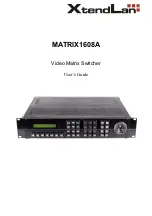
Rev. B
7-26
HMXMC001013
31-Mar-06
7.8
AUXILIARY CONTROL OUTPUTS, CONTINUED
7.8.2 Freeze
Frame
Control output (002)
has been defined to activate the FREEZE sequence of a video
frame store unit. A relay output module (RD-440) would be located in slot (13) of
subrack (1). Only relay contact (3) on this module is being used. Each relay on the one
module can be assigned for a different task.
A macro sequence can be executed to activate this relay output.
7.8.3 Door
Strike
Control output (003)
has been defined to activate an electric door strike. A relay output
module (RD-440) would be located in slot (14) of subrack (1). Only relay contact (3) on
this module is being used.
A macro sequence would be executed to activate this relay output for several seconds to
allow the door to be opened. Any one button on the keyboard could be used
(intercepted and redefined) to activate the door strike. This could relate dynamically to
the currently selected camera and/or preset view.
7.8.4
Remote Relay Outputs
Control output (004)
has been defined as a relay output located remotely at the PTZ
site receiver of camera (2). Some site receivers support an optional expanded I/O
board. This provides 8 separate relay contact closures.
For example this definition could be used to control the lighting in the area of the camera
site or possibly a door strike similar to the previous definition. With the exception of a
possible 0.5 second delay, a remote relay output can be considered the same as any
other defined auxiliary control output.
7.8.5 Boom
Gate - Open/Closed
In
control output
examples
(005)
and
(006)
two remote relay outputs located at camera
(2) have been defined. When the first relay (7) is activated a boom gate can be triggered
to open. When the second relay (6) is activated the boom gate can be triggered to close
again.
These relay outputs would normally be pulsed active (for maybe 1.0 second) by an
appropriate macro sequence. They could also be dynamically tied to specific camera
selection to simplify operator control.
7.8.6 Warning
Indicator
Sometimes it is required to have some form of ALARM ACTIVE annunciation (strobe
light, siren, etc.) in the control room to gain the operator's attention. Control output (007)
has been defined as relay (2) on the module located in slot (5) of the I/O subrack (17).
Activation of this output would be under control of the ALARM active macro sequences
associated with each alarm. Again it is the macro sequence that defines the operation of
the warning indicator.
















































